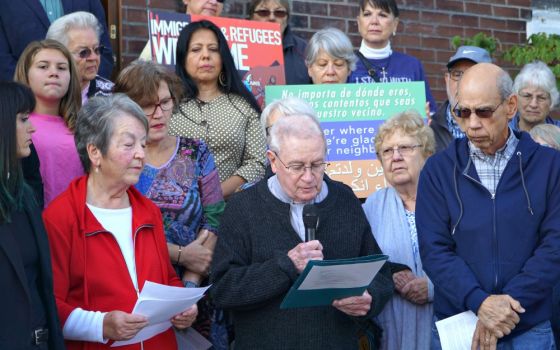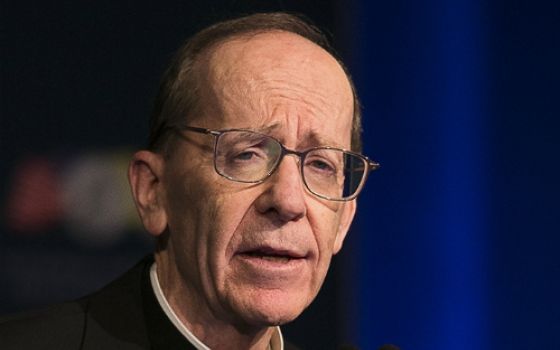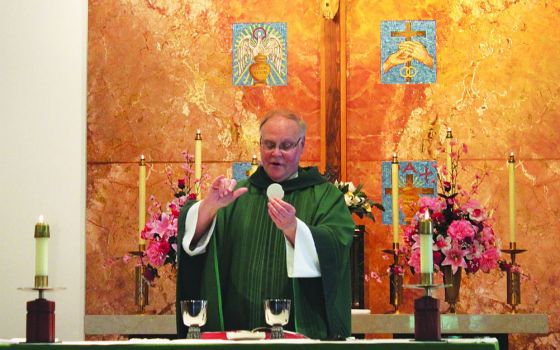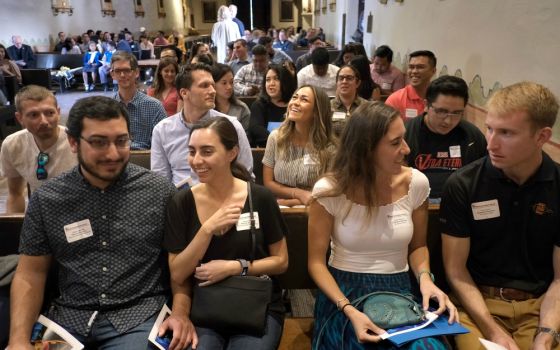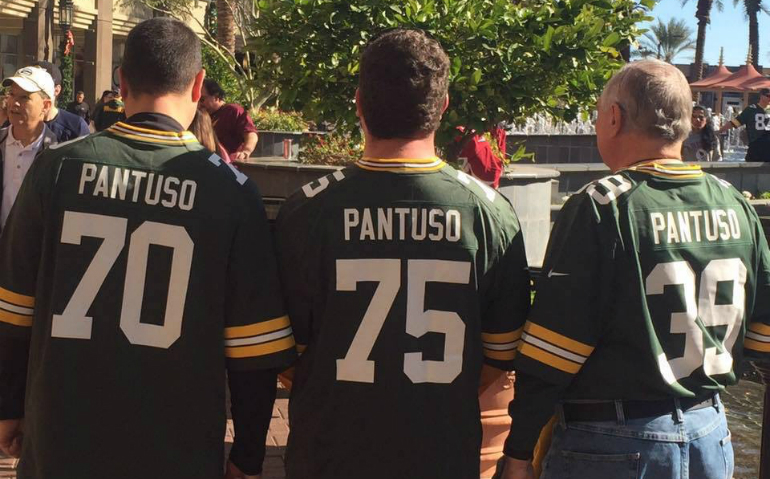
Honoring Salvatorian Fr. John Pantuso's dedication to the Green Bay Packers, his two sons, Bobby, left, and Joe, flew to Arizona for the Packer-Cardinals NFL game last Dec. 27. The Green Bay jerseys sport the men's years of birth. Arizona routed Green Bay 38-8. (Provided photo)
"The church has no problem touting the stories of married Episcopalian or Lutheran clergy being ordained priests, but it's a bit squirrelly about stories like mine," says Salvatorian Fr. John Pantuso.
His story? Entered seminary training in late 1950s for the Society of the Divine Savior (Salvatorians), first vows in 1960, ordained 1967, left priesthood, laicized, married, two sons, years of lay church work, widowed, renewed Salvatorian vows, reinstated as priest, named a pastor, retired.
"A bishop I will not name made a point of telling me not to make a big deal about my background when I started work in his diocese. Enough said," joked Pantuso in an email.
In yet another twist in Pantuso's tale, his son Bobby, to his father's surprise, was recruited as the key vocations staffer for the Salvatorians' U.S. province, headquartered in Milwaukee. Bobby and his wife, Nicki, have four sons -- Jacob, 14, Josh, 11, Joey, 9, and Jack, almost 2.
"As weird as it was for me when my dad became a priest again, it was weird for him that his son was the vocations director for his order," said Bobby Pantuso.
While it is unusual for religious communities to hire a lay person to oversee vocations work, it is at least as rare for a laicized priest who has been married to return to active priesthood.
"Not extremely rare, but not widely publicized," said the elder Pantuso. "I'm aware of several cases like mine, but I've never actually met someone with a similar story. No one has started a club for us yet."
There were 18 widowers at Sacred Heart Seminary and School of Theology in Hales Corners, Wisc., where Pantuso was enrolled for theological updating. The school specializes in older vocations. "The fact that I was already ordained made for some interesting conversations, and most found my story interesting," he said.
Son Bobby suggests his father be asked about the Sacred Heart seminary professor "who once told him to stop answering questions."
Elder Pantuso: "A few weeks into the Synoptic Gospels course, the prof asked me to come to his office before the next class. I did. He sat me down and said, 'In 20 years of teaching I have never said this to a student, but would you please stop participating so much?' "
Today's new vocations to priesthood are "generally older and more mature, so they are making better informed decisions" about pursuing ordination, he said.
"On the other hand," he added, "I don't think they are getting a solid enough grounding in theology and sacred scripture. I was fortunate to be exposed to the likes of Roland Murphy, Charles Curran, Carl Peter and John Tracy Ellis."
When a priest left ministry following the turmoil kicked off by the Second Vatican Council (1962-65), it was common for him to be treated as a persona non grata by some parishioners and church leaders. That was not Fr. Pantuso's experience.
"At the time I left (circa late 1968) that 'persona non grata' business probably applied to most" of the thousands around the world who also left during that era, he said. "It was certainly not true in the case of the Salvatorians I knew. It was differences like that they drew me to the Society in the first place."
How did parishioners react during his second term of priesthood when they learned he had been laicized, married, widowed and reinstated?
"The majority of parishioners responded very positively," he answered. "A very few ultra conservative types could simply not accept that I was really a priest -- and walked away. My background proved valuable in preparing couples for marriage and in helping those who had lost a spouse, and it never hurt in throw in a 'my wife' or a 'my kids' story in a homily."
Would a married clergy have an advantage in counseling engaged and married couples?

Salvatorian Fr. John Pantuso was reinstated to active priesthood in 2008 by Pope Benedict XVI. Pantuso had been laicized in the late 1960s and was widowed in 2002. (© 2016 Robert B. Watson/used with permission)
"Based on my experience," the widower said, "I would say yes, married priests can be more insightful and realistic in counseling. I had individuals and couples go out of their way to talk to me about their marriage problems and most of them came right out and said that they had come to talk to me because they knew I had been married. This does not mean that a priest who has never been married can't do a great job of counseling."
Where does he come down on the questions of married clergy and ordination of women?
"I'm on the email lists of the Women's Ordination Conference and Call to Action, so I don't think there's much question as to where I stand on the question of women deacons or women priests for that matter. The sooner the better," he emphasized.
However, he continued, "I think there will always be a place for the witness of celibacy, especially in the context of religious life, but it should certainly be optional for diocesan clergy.
"On the down side, I don't think Catholics are ready to financially support a married priesthood. More than 20 years ago, I asked a rabbi who served on an interfaith committee with me, how much he was paid. He said $80,000. He explained that his congregation was willing to do that because they wanted him to be free to study the Torah and not have to worry about paying the bills. Catholics aren't ready for that. And Joanne would agree with me on this."

John and Joanne Pantuso are pictured in front of Vail, Arizona's St. Rita of the Desert rectory with Salvatorian Fr. Bob Wicht, pastor, in 1996.
John and Joanne Pantuso had backboned myriad ministries. The couple worked several years in a public housing ministry in Maryland. When they later moved to Milwaukee, they became co-executive directors of the U.S. Lay Salvatorian program. They were also involved in the Milwaukee Archdiocese's Engaged Enrichment Program for 14 years.
"For the 20 years we lived in Wisconsin, we were members of a Salvatorian parish, St. Pius X in Wauwatosa," John said.
Joanne earned an Early Childhood Education degree and taught kindergarten in Catholic schools for 17 years.
With a degree in journalism from Marquette and graduate studies in theology, education and economics at Catholic University of America, John worked a handful of writing and editing jobs over the years including a decade as the director of publications for the New York-based Catholic League for Religious and Civil Rights (1987-96).
During his stint with the League, he designed a poster for the organization that was selected for the permanent collection of the Cooper Hewitt, Smithsonian Design Museum.
How does the senior Pantuso square his progressive theological stances with the Catholic League's well-known, stridently conservative agenda?
"When I joined the Catholic League staff it was still headed by Fr. Virgil Blum, its founder. The League had a reputation of being conservative, but Virgil was a good Jesuit and knew that the conservative label would keep the money coming in. ... When Bill Donohue was appointed, it started out well. He listened to advice early on. ... Before long he evolved into a self-inflating windbag and the League decided to close my office in Wisconsin right at the moment our friend [Salvatoriain] Fr. Bob Wicht invited Joanne and me to join him at his new parish in Arizona. We headed west."
So, in 1996 the Pantusos pulled up stakes and their sleeves and became core staff of St. Rita in the Desert Parish in Vail, Ariz., about a half hour southeast of Tucson.
John directed the parish adult education and the RCIA programs. Joanne established a pre-school religious education program and a parish outreach group. The pair served on the Social Justice Commission of the Tucson Diocese, which was heavily involved in U.S.-Mexican border issues. They also laid the groundwork for the first Lay Salvatorians in Tucson.
Joanne died suddenly in 2002 from a pulmonary embolism.
"Joanne was about 10 years younger than I, and I remember talking with her about the probability that she might well be a widow for a long time," recalls Pantuso.
"She told me she would die first. When I asked why, she said that I could live without her but that she couldn't live without me," he continued. "When I asked what I was supposed to do, she said, 'Go back to your brothers.' Well after her death, I tried my best to forget that she ever said that. I was going to sit there in my desert home and play the doting grandpa until the cows came home."
His return to active priestly ministry, he said, was jump started by a conversation he had with a Salvatorian priest friend while traveling home after a day of ministry at the state prison at Florence, Ariz.
The friend "told me about this priest in Fresno who had returned to the priesthood after he was widowed," said Pantuso. "He asked if I had ever considered doing that. My answer was 'yes' -- and that was the start of my journey back."
The now-retired Pantuso says, however, "It was never a question of 'returning' to ministry, but more a matter of taking it to another level. So, when I finally got around to asking in April 2003 if I could return to ministry as a priest, the response was immediate and it was positive."
Reaction from friends and family? Universally supportive, said Pantuso.
There were his own speed bumps, however. "As I began my return to the priesthood, the sexual abuse scandal was hitting the fans. I remember agonizing with my spiritual director over whether I really wanted to once again wear a Roman collar. In the end it came down to why I wanted to minister as a priest, and that overrode all other concerns."

Bobby Pantuso, associate director of vocations and director of advancement for U.S. province of the Society of the Divine Savior, headquartered in Milwaukee.
Son Bobby admits he felt "relief" at his father's decision. "I think a thought that haunts children when a parent dies is that they will end up in a relationship or even re-marry. Not that this was ever on the table, but I knew I wasn't going to have deal with a 'new mom' and that dad would have a support system. Beyond that though, he was pretty depressed about a year after my mom died. This gave him something to focus on and ultimately a second life."
One of that new life's exclamation points occurred Feb. 29, 2008, the day Pope Benedict XVI authorized a decree reinstating Pantuso to priesthood. He had renewed first vows in 2004 and final vows in early 2007.
The Vatican bureaucratic machinations at times were daunting, he said. However, the Salvatorian Generalate handled the entire process, working primarily with the Congregation for the Doctrine of the Faith.
"As far as the Salvatorians were concerned, my request was never a problem," Pantuso said. "Dealing with the Vatican, however, is a whole other matter. There were questions back and forth, holdups, and bureaucratic nonsense before it was all over."
In the years between Joanne's death and his reinstatement, Pantuso's assignments included working at the Salvatorian motherhouse in Rome where he helped redesign the order's international website "as well as numerous other print projects." He was also the director of communications for the U.S. province.

Then directed by Cardinal William Levada, the Vatican Congregation for the Doctrine of the Faith communicated Pope Benedict XVI's Feb. 29, 2008, reinstatement to active priesthood to Salvatorian Fr. John Pantuso.
Officially reinstated, the priest became associate pastor of two Salvatorian parishes in Wisconsin in July, 2008 -- his home parish of St. Pius X in Wauwatosa and Mother of Good Counsel in Milwaukee.
The next year he was appointed pastor of the Salvatorian parish in Sparta, Tenn., St. Andrew, where he served until retirement early last year.
Bobby Pantuso says his father's story pays dividends in vocations work. "People are always amazed in a very positive way. It's fun for me to watch the wheels turn as they try to wrap their heads around it," the younger Pantuso said.
"It becomes a key part of getting to know men when they first begin to discern. It helps lay the foundation for them about where I'm coming from, but more importantly it helps to build trust at the beginning of our relationship."
"For lack of a better way to explain it," added the son, "I was raised Salvatorian. My parents were Lay Salvatorians before I was even born, and so growing up a lot of my 'aunts' and 'uncle' were either Lay Salvatorians, sisters, brothers, or priests."
While being "Salvatoriain" was part and parcel of his life, Bobby Pantuso says the realization and implications of his father having been an ordained priest grew.
"I guess I was aware of it because we were so close with the Salvatorians," he explained, "but I think the moment it became real for me was when I was about 11 or 12. I found out that if there were ever a time someone needed emergency last rites, my dad would not only have been able, but obligated, to administer them because when you leave the priesthood you are laicized, not 'un-ordained.' "
Bobby and his older brother, Joe, "grew slowly but surely in their awareness of my background," said Fr. Pantuso. "When your closest family friends are priests and brothers and sisters and Lay Salvatorians, you sooner or later decide your family is really weird. How many kids would pick a Salvatorian sister to be their Confirmation sponsor? When dad has a purple stole and a book with the last rites in the glove compartment, you might ask questions. When you find a silver chalice and paten in a black case in the closet, you might ask questions. You get answers."
Founded in 1881, the Salvatorians work in parishes, hospitals, nursing homes, prisons and other "communities under duress" in 43 countries, states their website.
In addition to the Society's congregation of priests, deacons and brothers, the Salvatorian family includes the Congregation of the Sisters of the Divine Savior and the Lay Salvatorians (International Community of the Divine Savior).
Globally the Salvatorians count three bishops, 836 priests, five permanent deacons, 131 brothers, and 131 scholastics. The U.S. province has 88 priests and brothers "including those in formation," officials said.
There are 1,046 Salvatorian sisters world-wide with 65 in the U.S. Lay Salvatorians number about 1,500 globally, 165 in this country.
[Dan Morris-Young is NCR's West Coast correspondent. His email is dmyoung@ncronline.org.]
We can send you an email alert every time The Field Hospital is posted. Go to this page and follow directions: Email alert sign-up.

